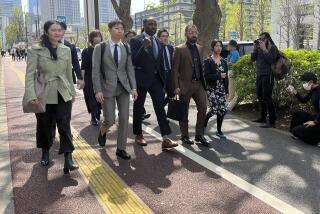Japanese Health Care System Called Too Fair : Medicine: The downside of low cost and easy access to doctors is that patients wait hours for short consultations.
- Share via
TOKYO — As the United States struggles to make its health care system serve more people better, many Japanese say theirs has become too fair.
“You have first class, business class and economy class on airplanes, why not in a medical system?” asked Hiroshi Shimizu, a dermatologist at Keio University Hospital in Tokyo.
In Japan, people live longer than anywhere else in the world, fewer babies die, there are more CAT scanners and other advanced devices per capita, and on top of all that, medical costs per person are lower than in most other countries.
Yet patients have fretted for years about enduring long waits, then barely getting a glance from a harried doctor. The doctors are beginning to agree with them.
A sacred tenet in postwar Japan has been the guarantee of cheap, equal medical care for everyone. By government decree, an initial consultation with a hospital internist, for example, costs only $16 everywhere in the country, about one-third of what most U.S. doctors charge. A second visit is $4.
As a result, physicians say, it is difficult to be conscientious and still make a living, or for patients to feel like anything but cattle.
“If you can share only a few minutes with each patient, then the treatment tends to be very superficial,” said Yasuhiro Suzuki, a Health and Welfare Ministry official who also is a practicing physician. “But on the other side, it increases access of patients to medical doctors.”
Shimizu, the dermatologist, said he typically sees 60 patients in four hours, an average of one every four minutes.
“I feel like a shoe salesman sometimes,” he said. “Even if you have a very difficult patient, you have to charge the same fee. But if you spend 30 minutes for each patient, you can’t survive in Japan.”
Many hospitals and doctors make up for low fees by controlling the dispensing of drugs, setting their prices and, it is said, often overprescribing.
Responding to complaints about fees, the government changed the system last spring to recognize that some doctors and hospitals give better care than others.
Hospitals with larger rooms and more physicians and nurses per patient are allowed higher fees. The system also tries to undo a major flaw: Because fees are the same everywhere, patients flock to the best hospitals.
“Even if they just have a cough, they’ll go to the hospital and get a CAT scan and a blood test,” Suzuki said.
By manipulating fees, the government will try to direct patients with minor ailments to private clinics and people with more serious illnesses to hospitals.
Medical insurance in Japan averages about $100 a month per employee, far less than some of the cheapest plans of health management organizations in the United States.
Malpractice lawsuits are rare, partly because the legal system is heavily weighted toward defendants and partly because doctors are revered, almost never challenged. Often, Japanese doctors do not even tell patients what is wrong with them.
The ultimate, ironic effect of all this is that, for all the troubles of the U.S. health care system, Japanese seem to like theirs even less.
According to a 1991 Louis Harris poll, only 12% of Japanese were “very satisfied” with their health care services, compared to 55% of Americans and 45% of Germans.
“Sometimes, I feel that a five-minute diagnosis after a two-hour wait is less than I deserve,” said Eiko Oka, a patient at Keio University Hospital.
Americans in Japan are sometimes shocked by the callousness of treatment. Claudia Turley, whose husband was an executive in Japan, related how they spent a weekend waiting for treatment for his broken knee. No doctor could be found until Monday.
“He was in terrible pain,” she said. “Finally, he went into shock.”
Government officials and academics, for example, often boast of Japan’s churyuishiki --middle-class consciousness.
Greater affluence has led to social gaps, however, and a demand for differentiated medical care. At the same time, the cost of the insurance to government is ballooning because the number of people not working, most of them elderly, has jumped from 6.4% in 1965 to 33.5% in 1990.
Health Care Compared Annual per capita expenditures in selected industrialized countries:U.S.: $2,566 France: $1,543 Germny: $ 1,487 Sweden: $1,479 Japan: $1,171 Source: Organization for Economic Cooperation and Development






